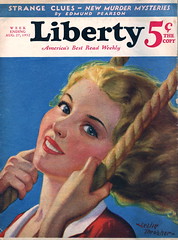A “Japanese” salad from a Russian princess

But, have no fear — I do at least have an old recipe for you to enjoy today. This is from the August 27, 1932 issue of Liberty magazine, page 50, in the “To the Ladies!” column by Princess Alexandra Kropotkin (“linguist, traveler, lecturer, and authority on fashion” — she was the London-born daughter of the famous Russian anarchist Peter Alexeyevich Kropotkin).
The column begins with a blurb about actress Anna May Wong, and, after some jokes, anecdotes, and a plug for the book Blonde Interlude by Bourke Lee, ends with a recipe:
“With extreme daredeviltry I give you a Japanese salad on the same page with a Chinese movie star. I may be starting another war, but here goes:
“To begin making this Japanese salad you first peel some potatoes and cook them in meat bouillon with a bay leaf. Dice the potatoes while warm. With every two cups of diced potatoes use one cup of cut-up shrimps, half a cup of diced tongue, and two tablespoons of chopped chives.
“For the dressing use one tablespoon of the hot bouillon in which the potatoes were cooked, one tablespoon of vinegar, two of salad oil, a scant tablespoon of sugar, half a teaspoon of soy sauce, pepper, and a speck of ground mace. Chill well.
“Make a border of the Japanese mixture and fill the center with lettuce leaves sprinkled with French dressing. Decorate with little mounds of chopped beets.”
I am pretty certain I won’t be making this one. It contains two things that are Kryptonite to me: tongue and beets. I once had a traumatic experience when I was invited to dinner with a boyfriend’s parents, and the dinner consisted of boiled, unseasoned tongue sliced in cross-section (the father could not have salt and apparently anything else that makes food taste interesting was off-limits, too) and canned string beans. (The only drink offered was water, which might have been all right if the food was edible, but it was not. I imagine the average prison food is better. It certainly is likely to have more flavor.) So tongue was off the menu for me after that, even when I did still eat beef.
I don’t know how “Japanese” this salad actually is. It strikes me as pretty western, despite the half teaspoon of soy sauce. If this actually is Japanese, I would love to know.
